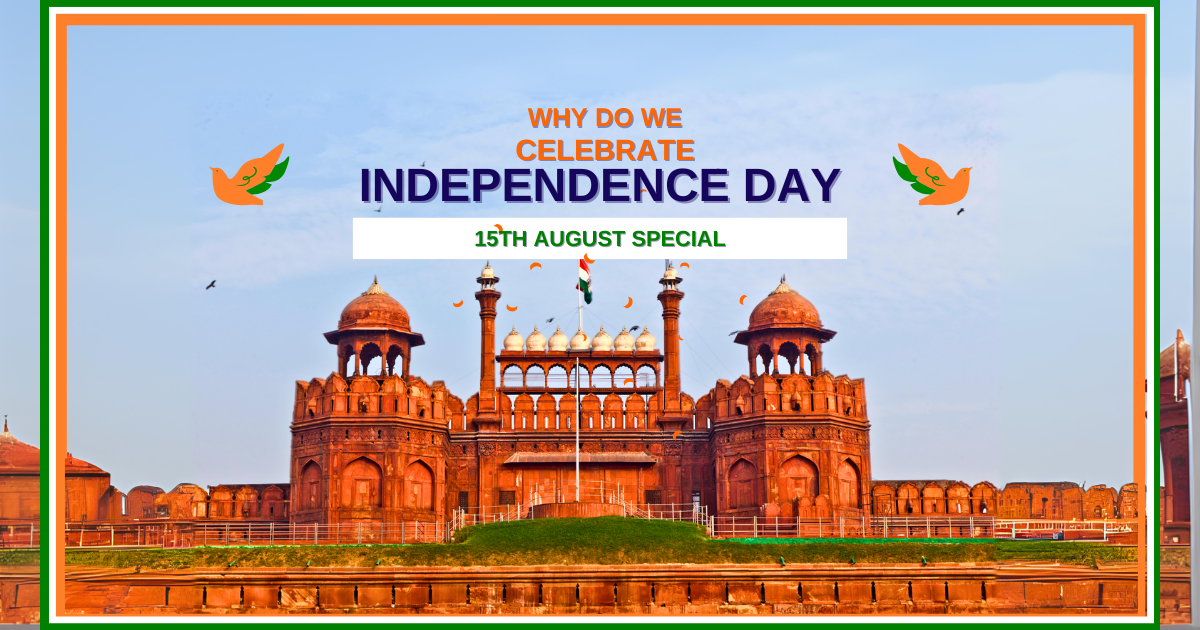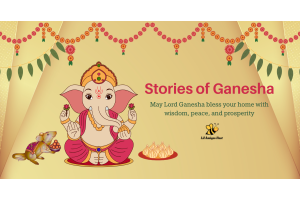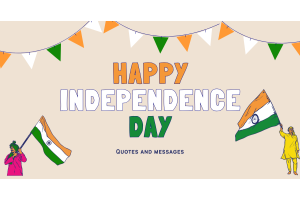Why do we celebrate independence day on 15th august? [History, Facts & More}

Every year, Independence Day India is celebrated with unparalleled enthusiasm on 15th August. But why do we celebrate Independence Day on 15th August? This question lies at the heart of our national identity and historical journey. In this blog, we’ll explore the origins of that fateful date, delve deep into Indian history, highlight the difference between Republic Day and Independence Day, and share some fascinating facts about India that make this celebration so special.
As we honor our freedom, it’s essential to understand not just the ceremony but the story—how British colonial rule ended, why the date 15th August 1947 was chosen, and how it contrasts with the day we adopted our Constitution. Whether you’re a student revising for exams or simply curious about our heritage, this blog will provide a comprehensive, plagiarism‑free account in simple English and a confident tone.
The Road to Freedom: A Brief History
-
Early Struggles and Movements
-
From the Sepoy Mutiny of 1857 to the rise of the Indian National Congress in 1885, generations of freedom fighters sought an end to foreign rule.
-
Leaders like Mahatma Gandhi, Jawaharlal Nehru, and Sardar Patel mobilized masses through nonviolent protests—non‑cooperation, civil disobedience, and Quit India Movement—laying the groundwork for eventual freedom.
-
-
World War II and Its Aftermath
-
The strain of World War II weakened Britain economically and politically.
-
Amidst mounting pressure at home and abroad, the British government realized that ruling India was no longer sustainable.
-
-
Mountbatten Plan and Transfer of Power
-
Lord Louis Mountbatten was appointed India’s last Viceroy.
-
The Indian Independence Act was passed in July 1947, which partitioned British India into the two dominions of India and Pakistan.
-
15th August 1947 was chosen as the official date for the transfer of power because it offered sufficient time to finalize boundary demarcations and administrative handovers.
-
Why 15th August? The Significance of the Date
-
Symbolic Timing: 15th August was historically significant for the British—VJ Day (Victory over Japan) was celebrated on that date in 1945.
-
Administrative Practicality: The Partition Commission needed time to define borders and prepare both nations for a smooth transition.
-
Global Context: Setting the date on 15th August allowed Britain to formally end hostilities in Asia with the conclusion of World War II and shift focus to peacetime governance.
This convergence of historical events made 15th August the most suitable day for India to step onto the global stage as a free nation.
The Grand Celebrations: How Independence Day in India Is Observed
-
Flag Hoisting and Patriotic Songs
-
The Prime Minister hoists the national flag at Red Fort, Delhi, followed by the national anthem “Jana Gana Mana.”
-
Across the nation, schools, colleges, and local bodies conduct flag‑hoisting ceremonies and sing patriotic songs like “Vande Mataram.”
-
-
Cultural Programs and Parades
-
Colorful cultural displays reflect India’s diversity—folk dances, regional music, and dramatizations of freedom struggles.
-
March‑pasts by the armed forces, National Cadet Corps (NCC), and various civilian contingents showcase the country’s unity and strength.
-
-
Honoring Heroes
-
Gallantry awards and civilian honors (e.g., Ashoka Chakra, Kirti Chakra) are conferred to recognize bravery and service.
-
Wreath‑laying ceremonies at Amar Jawan Jyoti pay homage to martyrs.
-
-
Digital Celebrations
-
In recent years, virtual events, 3D flag hoists, and social media campaigns (#IndependenceDayIndia) amplify patriotic fervor online.
-
Difference Between Republic Day and Independence Day
| Feature | Independence Day | Republic Day |
|---|---|---|
| Date | 15th August | 26th January |
| Marks | Transfer of power from Britain (1947) | Adoption of the Constitution (1950) |
| Signature Event | Flag hoisting at the Red Fort | Grand parade at Rajpath |
| Main Theme | Political freedom | Constitutional democracy |
| Holiday Status | National holiday | National holiday |
-
Independence Day commemorates India’s freedom from colonial rule, while Republic Day celebrates the day our Constitution came into effect, making India a sovereign republic.
-
Though both are national holidays and feature parades, their historic contexts and symbolic meanings differ significantly.
Key Milestones in Indian History Leading to 15th August
-
1857: First War of Independence
-
Often referred to as India’s first major attempt to overthrow British rule.
-
-
1885: Formation of the Indian National Congress
-
The INC became the principal platform for civil and political dialogue.
-
-
1919: Jallianwala Bagh Massacre
-
A turning point that galvanized public opinion against British oppression.
-
-
1930: Salt March (Dandi March)
-
Gandhi’s 240‑mile march protested the British salt monopoly.
-
-
1942: Quit India Movement
-
Nationwide call for British withdrawal; many leaders were jailed.
-
-
July 1947: Indian Independence Act
-
Legally ended British suzerainty and set the stage for the birth of two nations.
-
-
15th August 1947: Independence Day
-
India and Pakistan emerged as independent dominions.
-
Fascinating Facts About India’s Independence
-
First National Flag: The first version of India’s tricolor flag was hoisted on 7th August 1906 in Calcutta.
-
Young Freedom Fighters: Many underage revolutionaries, like Khudiram Bose (17) and Bhagat Singh (23), sacrificed their lives for freedom.
-
Partition’s Human Cost: Over 10 million people were displaced, and nearly one million lost their lives in communal violence.
-
First Speech as PM: Jawaharlal Nehru’s iconic “Tryst with Destiny” speech was delivered on the eve of Independence (14th August 1947, late night).
-
Global Impact: India’s nonviolent struggle inspired civil rights movements worldwide, including Martin Luther King Jr. in the USA.
Why Do We Celebrate Independence Day on 15th August — Beyond the Date
-
Honoring Sacrifice
-
Millions contributed—leaders, activists, soldiers, and ordinary citizens. Independence Day pays tribute to their unwavering commitment.
-
-
Renewing National Unity
-
In a land of immense diversity, coming together on 15th August reinforces our shared identity as Indians.
-
-
Celebrating Democratic Values
-
Freedom of speech, equality, and justice are cornerstones of our Constitution, which we honor by celebrating the gift of independence.
-
-
Inspiring Future Generations
-
Schools and colleges use this day to teach young minds about the struggles and triumphs that shaped modern India.
-
Independence Day and Modern India
-
Economic Growth: From a fledgling economy in 1947 to one of the world’s fastest‑growing major economies, India’s journey is remarkable.
-
Technological Leap: India’s space program (ISRO) and IT revolution showcase our strides in science and innovation.
-
Cultural Renaissance: Bollywood, Indian cuisine, and classical arts have gained global acclaim, reflecting India’s soft power on the world stage.
Each year on 15th August, we not only remember the past but also celebrate the promise of tomorrow.
Celebrating in Every Corner: Regional Traditions
-
North India: Flag hoisting followed by kite festivals in Delhi and Chandigarh.
-
West Bengal: Cultural processions featuring tableaux of historical events.
-
Punjab: Traditional folk dances like Bhangra and Gidda are performed in community gatherings.
-
South India: Patriotic plays (e.g., “Poratam”) and special editions of classical music concerts.
-
North‑East: Indigenous tribes organize sports meets and cultural shows.
These regional expressions add vibrant colours to the nationwide celebration.
How You Can Participate
-
Attend Local Events: Check with your municipality or cultural center for flag‑hoisting ceremonies.
-
Volunteer: Join cleanliness drives, blood donation camps, or educational outreach programs.
-
Educational Outreach: Share stories of freedom fighters with children to keep history alive.
-
Digital Campaigns: Use social media hashtags (#15th August, #IndependenceDayIndia) to spread awareness and patriotic messages.
Active participation deepens our connection to the nation’s legacy.
FAQs
Q1. What happened on 15th August 1947?
A: India formally gained independence from British rule, and the Indian Independence Act came into effect.
Q2. Why not celebrate on 26th January?
A: 26th January was chosen for Republic Day in 1950 because it marked the day the Constitution was adopted. Independence Day commemorates freedom in 1947.
Q3. How long did the struggle for independence last?
A: While formal resistance peaked in the 20th century, early rebellions date back to the mid‑19th century, making it a century‑long struggle.
Q4. Can I watch the Prime Minister’s address online?
A: Yes, live streams are available on Doordarshan, All India Radio, and official government YouTube channels.
Every 15th August, as the tricolor flutters against the sky, we are reminded of our forebears’ unwavering courage and sacrifice. Celebrating Independence Day India is more than a holiday; it’s a reaffirmation of our values, unity, and hopes for the future. Understanding why we celebrate Independence Day on 15th August deepens our appreciation for the freedoms we enjoy today and inspires us to build an even stronger nation.
Let this Independence Day ignite pride in our hearts and a commitment to uphold the principles that make India truly free.



























